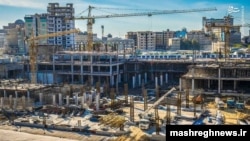The head of Iran's Holy Shrines' Reconstruction Headquarters, Mohammad Jalal Ma'ab, says, despite the coronavirus epidemic in Iraq, building the "Zaynab Courtyard" project in the city of Karbala "continued unabated".
According to the state-run Iran Students News Agency, ISNA, Ma'ab said that pouring concrete for the columns of the building is currently underway.
Meanwhile, the Islamic Republic officials are discussing with their counterparts in Iraq’s Shiite religious cities, including Najaf, to begin other projects, Ma'ab said. He also also announced that the headquarters has resumed its activities in Damascus and is developing Zaynab's sanctuary in the Syrian capital city.
Zaynab, also spelled Zainab, was the daughter of the first Shiite Imam, Ali ibn Abi Talib and Fatimah, daughter of Prophet Muhammad.
No one knows the exact date and place of her death, but she probably died in the year 62 AH (681/682). Therefore, her burial place has not been determined.
The construction of Zaynab's courtyard in Karbala, which covers an area of 168,000 square meters (approximately 41.5 acres), is part of Imam Hussein (Shi'ites' third Imam and brother of Zaynab) courtyard development project, which has been under discussion since 2013.
The estimated cost of construction of the courtyard has been on average up to 45 million rials (about $1000) per square meter, or 7.56 trillion rials (roughly $168 million) in total.
Assisted by 2,000 Iranian workers, the courtyard is under construction on four floors as part of Imam Hussein's shrine development project.
The Iranian government has another project underway in Karbala, called the sanctuary of Hazrat Zahra (Prophet Mohammad's daughter, and mother of Zaynab). The shrine has an area of 220,000 square meters (roughly 54.3 acres), which is estimated to cost more than ten trillion rials (about $238 million).
This is amid serious economic crisis in Iran, where the government is running out of cash and resorts to printing money. Iran has been withdrawing money from its foreign currency reserves in the past two years to sustain its essential operations.
According to a senior official at the Holy Shrines Reconstruction Headquarters, the building of the courtyard in Karbala was handed over to the Islamic Republic government's representatives after a Lebanese Shiite cleric saw a dream that the Prophet of Islam gave "Zaynab's cradle" to an Iranian Grand Ayatollah, Mohammad Taqi Bahjat Foumani, who died at 92 in 2009.
Meanwhile, since last June, the officials of the Holy Shrines (Atbat-e-Aliat) Reconstruction Headquarters have launched a project called "Qassem Soleimani" which aims to fulfill the slogan "Every Iranian, 5,000 Tomans (about $1.20)" to help to build the courtyard of Hazrat Zainab in Karbala.
Last March, Washington imposed sanctions on the Reconstruction Organization of the Holy Shrines in Iraq with a batch of sanctions.
The U.S. Treasury Department has described the entity as an organization based in Iran and Iraq, controlled by the Qods Force. Also targeted by the sanctions is the organization's executive chairman, Mohammad Jalal Ma'ab.
An Iranian citizen from the town of Kerman, Ma'ab, was appointed to the post in 2019 by Qassem Soleimani, the IRGC's Qods Force Chief Commander who was killed by a U.S. drone attack in early January, outside Baghdad international airport.
Iran's efforts to rebuild Twelver-Shiite religious sites in Iraq began in 2003. The Headquarters for the Reconstruction of the Holy Shrines, a subdivision of the IRGC's Qods Force, has been responsible for more than 155 projects in Iraq and Syria, so far.
The headquarters has also been active in various Iraqi cities, such as Najaf, Karbala, Al-Kāẓimiyyah (a northern neighborhood in Baghdad), Kufa, Samarra, Musayyib, and Balad, and has been operating in Syria since 2014.






